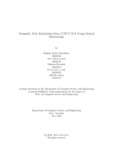| dc.contributor.advisor | Mostakim, Mr. Moin | |
| dc.contributor.advisor | Khondaker, Ms. Arnisha | |
| dc.contributor.author | Chowdhury, Iftekhar Kabir | |
| dc.contributor.author | Jarif, Md. Nahiyan | |
| dc.contributor.author | Showmik, Sadman | |
| dc.contributor.author | Oishi, Farah Farhin | |
| dc.contributor.author | Bin Jinnat, Afif | |
| dc.date.accessioned | 2022-12-14T07:34:21Z | |
| dc.date.available | 2022-12-14T07:34:21Z | |
| dc.date.copyright | 2022 | |
| dc.date.issued | 2022-05 | |
| dc.identifier.other | ID: 18101463 | |
| dc.identifier.other | ID: 18101348 | |
| dc.identifier.other | ID: 18101124 | |
| dc.identifier.other | ID: 18101033 | |
| dc.identifier.other | ID: 18101047 | |
| dc.identifier.uri | http://hdl.handle.net/10361/17648 | |
| dc.description | This thesis is submitted in partial fulfillment of the requirements for the degree of Bachelor of Science in Computer Science and Engineering, 2022. | en_US |
| dc.description | Cataloged from PDF version of thesis. | |
| dc.description | Includes bibliographical references (pages 44-46). | |
| dc.description.abstract | CAPTCHA stands for Completely Automated Public Turing Test to distinguish
Computers and Humans Apart. CAPTCHA is used for a variety of reasons, includ ing internet security. There are various CAPTCHA methods available nowadays,
including text-based, sound-based, picture-based, puzzle-based, and so on. The most
prevalent variety is text-based CAPTCHA, designed to be easily recognized by hu mans, frequently used to separate people from automated applications, and challeng ing to understand by machines or robots. However, as deep learning advances, it’ll
become much easier to create Convolutional Neural Network (CNN) models which
will successfully decipher text-based CAPTCHAs. The CAPTCHA-breaking work flow consists of attempts, techniques, and enhancements to the computation-friendly
Convolutional Neural Network (CNN) version that aims to reinforce accuracy. In
comparison to the break of the whole CAPTCHA shutter at an equivalent time to
separate CAPTCHA images for individual characters from 2 pixels on the corner of
the sector with a replacement set of coaching data, then offered an efficient division
of the network separation to interrupt the transmission of CAPTCHA text. Se mantic textual content segmentation may be a natural step in developing coarse to
first-class inference. The inspiration is often placed in classification, which creates
a prediction for a whole input. | en_US |
| dc.description.statementofresponsibility | Iftekhar Kabir Chowdhury | |
| dc.description.statementofresponsibility | Md. Nahiyan Jarif | |
| dc.description.statementofresponsibility | Sadman Showmik | |
| dc.description.statementofresponsibility | Farah Farhin Oishi | |
| dc.description.statementofresponsibility | Afif Bin Jinnat | |
| dc.format.extent | 46 Pages | |
| dc.language.iso | en_US | en_US |
| dc.publisher | Brac University | en_US |
| dc.rights | Brac University theses are protected by copyright. They may be viewed from this source for any purpose, but reproduction or distribution in any format is prohibited without written permission. | |
| dc.subject | CAPTCHA | en_US |
| dc.subject | Convolutional neural networks | en_US |
| dc.subject | Recurrent Neural Networks. | en_US |
| dc.subject.lcsh | Neural networks (Computer science) | |
| dc.title | Semantic text extraction from CAPTCHA using Neural Networking | en_US |
| dc.type | Thesis | en_US |
| dc.contributor.department | Department of Computer Science and Engineering, Brac University | |
| dc.description.degree | B. Computer Science and Engineering | |

